Reprinted from Wildlife Conservation Magazine
November/December 2005
December 2002. After four days traveling upriver in a dugout canoe, Belgian primatologist Jef Dupain became the first researcher in five years to return to the war-torn Lomako Forest in the Democratic Republic of Congo (DR Congo). As he surveyed the overgrown field station that had once been his home, a boy soldier wielding an AK-47 stepped into view from a concealing tangle of vines. Fortunately the boy was only one of the rebel fighters who had escorted Dupain behind enemy lines into this lush forest, which lies along the front between the Congolese Army of President Joseph Kabila and the Movement for the Liberation of Congo, a rebel group intent on toppling the government.
The Congolese civil conflict that erupted in 1997, forcing Dupain to abandon his work, has exacted a devastating toll. As many as three million people have been killed and many millions more displaced by the warring factions. But in 2002, with United Nations peacekeeping forces deployed throughout the country, Dupain took advantage of the relative calm to check on the condition of the Congolese primate he had been studying -- the endangered bonobo. Prior to the war, researchers estimated that fewer than 10,000 bonobos were alive in DR Congo, their sole home on Earth. How had they fared during the turmoil?
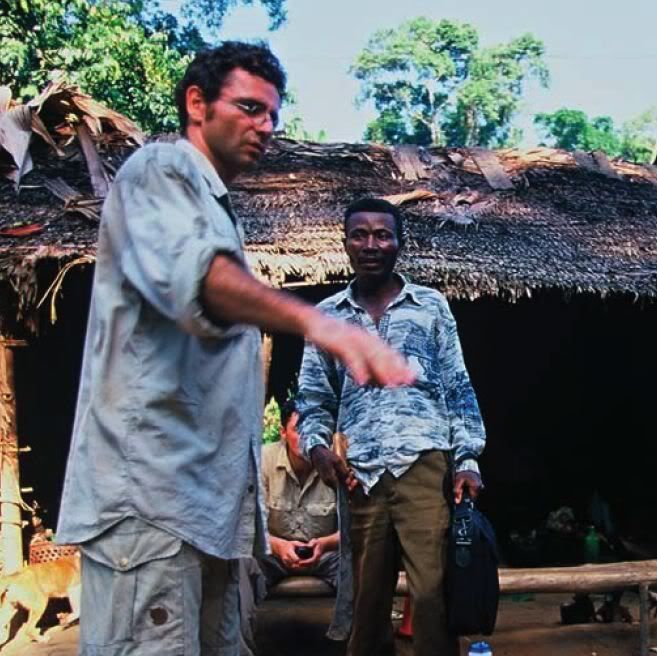
Jef Dupain, a primatologist, studies bonobos in the forests of the Democratic Republic of Congo, a country struggling to make peace after years of civil war.
Sometimes called the pygmy chimpanzee, the bonobo was officially recognized in 1929 as a separate species, Pan paniscus from the chimpanzee, P. troglodytes, based on examination of a skull in a Belgian museum. The bonobo's name, Pan derives from the vivacious Greek forest god; paniscus indicates diminutive stature, although bonobos and chimpanzees are similar in size.
During the 1970s, Japanese and Western scientists began to study elusive bonobo in the wild. What they found upset notions of aggressive behavior in primates and raised fundamental questions about the male-based model of human evolution. Such popular books as Man the Hunter, Demonic Males or The Dark Side of Man described violent behavior among our closest relatives. By contrast, primatologist Franz de Waal calls bonobos--a species that shares 98.7 percent of its genetic makeup with humans--the “Make Love Not War hippies of the animal kingdom."
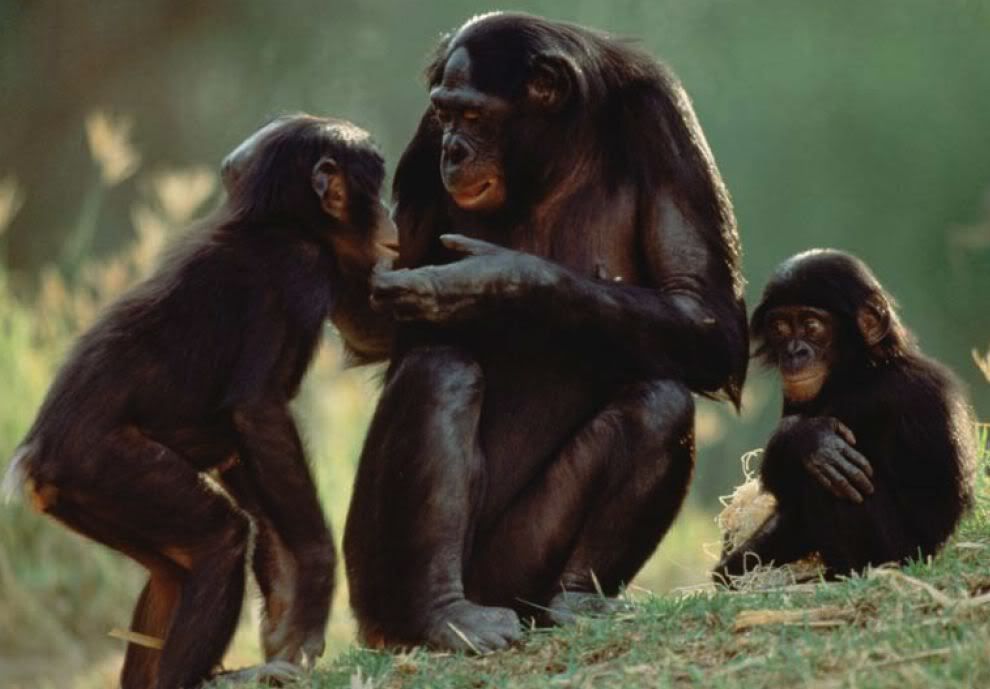
A mother bonobo lifts the head of her youngster to better look into her eyes. Considered to be the most human-like of all primates, bonobos can walk bipedally, and unlike other apes, they form cooperative groups of non-related females.
“[Bonobos are] not free of aggression,” adds Frances White, a University of Oregon primatologist and long-time colleague of Dupain, “I have seen knock-down, drag out fights.” But compared to chimpanzees or gorillas, bonobos are very egalitarian and form cooperative groups of non-related females--unheard of in other non-human anthropoids.
“Evolutionarily, it makes sense that, if you’re going to help someone, you help a relative,” explains White. From an evolutionary standpoint the goal--though not a conscious one--is to pass as many of your genes as possible to the next generation. Natural selection would favor those behaviors that resulted in reproductive success and the survival of close relatives. “So it was thought very strongly that unrelated females would not cooperate together in a group,” White continues. “The fact that they do is really unique.”
But the real shock to researchers was the sexual behavior of bonobos, which involves frequent same-sex couples, sex as play, sex to avoid aggression, and sex to make up after fights. Whereas sexual activity is often a distinct category for reproduction purposes only in other animals, with bonobos it's the glue and salve of their social lives, and any description of their societies would be incomplete without it. Referred to as pansexual, bonobos engage in a gamut of pleasures: genito-genital rubbing between adult females, male-male mountings, what has been termed, “penis fencing,” oral sex, tongue kissing and, what may be most alarming to human vanity, face-to-face mating between females and males. Bonobos definitely contradict the notion that sex is intended solely for procreation. In doing so, they invoke the image of their Greek namesake dancing lasciviously with the nymphs and satyrs of Arcadia.
“Although, you have to be careful,” says White, “because even though females will mate with all males its not just mating with all males indiscriminately or for no reason. Mating happens for many different reasons.”
In fact, females become extremely choosy around the time of ovulation and will frequently form consortships with a single male, sneaking off into the forest together for several days. There are also frequent examples of sexual coercion, a behavior common in all primates.
“I have seen males aggressively charge--screaming with their hair raised, mouth open and teeth bared--jump on and bite at females,” says White. This often leads to the female screaming, retreating a yard or so and initiating sex to calm down the males.
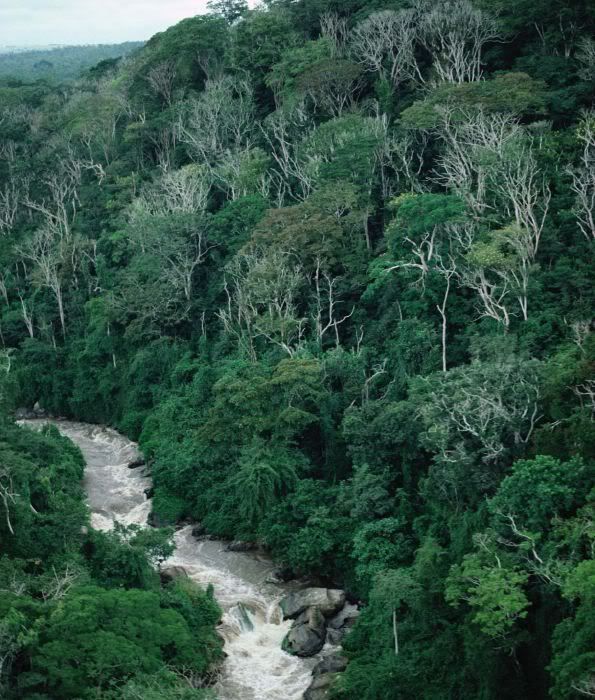
What Jef Dupain witnessed, however, when he returned to his former Royal Zoological Society of Antwerp field station was not the simian equivalent of Bosch’s “Garden of Earthly Delights,” but more the forsaken landscape of Rousseau’s ironically titled “Virgin Forest.” The irony is that the great ape that is considered to be the most peaceful of all primates had had its paradise shattered at the hands of the most violent.
“During those weeks we found almost no nests of bonobos, no monkeys, and almost no traces of ungulates,” says Dupain. "The few monkeys we did see reacted like monkeys that were very used to hunting." This was hardly a surprise since Dupain saw soldiers pass by in the forest carrying slaughtered wild pigs and colobus monkeys, and the villagers who had formerly been under his employ admitted that they had resorted to hunting the very animals they had once been paid to protect.
“The people had been waiting for us to come back so they could assist in our research, and at some point, they lost hope” says Dupain. "Then of course they started hunting themselves and no longer reacted to hunters coming in from outside."
This is how war erodes conservation efforts. Fleeing the violence of warring factions, homeless refugees push deep into the virgin forest. Settled villagers who could once earn a living selling their crops in urban districts find it too dangerous to plant their fields, so the land lies fallow. Or, if they are able to harvest, there's no way to transport it to market. For soldiers, refugees, and villagers, killing wildlife becomes a way to survive.
The rise in this bushmeat crisis in Congo has been documented by Wildlife Conservation Society field biologist John Hart. “The trends are disturbing,” he says, “particularly the increase in the number of bonobos killed in areas where they had not been seriously threatened before.”
While there are some protected areas (on paper at least), such as Salonga National Park, or minimally protected regions at Lac Tumba or the Lokuru Reserve, the majority of bonobo habitat, including the Lomako Forest, remains unprotected. This means that community involvement to self-enforce a ban on bushmeat is the only safety net for wildlife.
Offering employment to people who have few other opportunities can be the best hope to encourage communities to value their endangered species. “Hiring local people as part of field survey teams, even as park guards, can be an effective way to establish a link with the community,” says Hart. The emerging reality of conservation is that, to protect the endangered bonobo, economic alternatives have to be made available for humans who share their range.
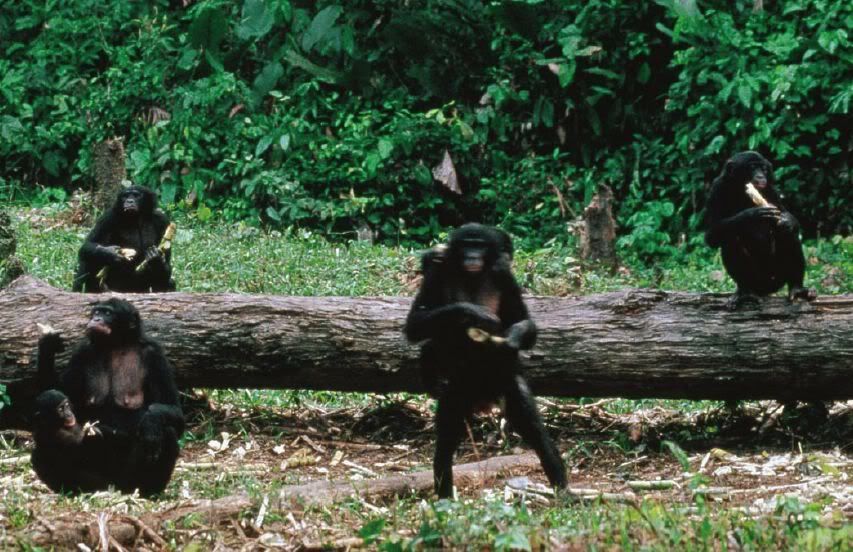
Bonobos finish up a meal of sugarcane in Wamba, northern DR Congo, the site of the longest running study of bonobos in the wild. By growing sugarcane for these animals, primatologist Takayoshi Kano enticed them out of the forest and won their trust. Kano's pioneering fieldwork revealed much about the bonobo's social life.
That's why Jef Dupain is setting up a project for the African Wildlife Foundation to organize the transport of crops from the Lomako Forest region to DR Congo's interior markets. “If we can reopen the markets for these people,” says Dupain, “fifty percent of those who stay in the forest and hunt will return to their villages and start working on their plantations again. For me, that’s conservation at the moment in Congo.”
Dupain is also meeting with the Institute Congolo pour le Conservation de la Nature (ICCN), the national agency in charge of protected areas, to establish an official reserve in the Lomako Forest. “We did surveys throughout the landscape and identified specific areas with high potentials for conservation,” says Dupain. The difficulty, as always, is finding sources of funding for the basic infrastructure, such as salaries for park guards and further field surveys to determine the boundaries of bonobo habitats.
In the most recent survey of the Lomako Forest, in late 2004, Dupain found more bonobos than expected, but with population levels still dangerously low: at pre-2002 levels, or about two individuals per square kilometer. “That means the people are telling the truth,” reasons Dupain. “The villagers killed a lot of animals. Probably they killed some bonobos, too, but they also told us in 2002 that bonobos had left the area to get away from the hunters. It seems that, in the last few years, the people started believing again that we might come back, so they decreased their hunting, and now bonobos are back in the area. This is indeed a very positive surprise.”
But Dupain’s cautious optimism depends upon the international community’s response to Congo’s humanitarian and natural resource crisis. “We are facing increased hunting pressure and forestry activities [logging] all over the area,” says Dupain. “We also have to worry about the susceptibility of these great apes to diseases that might decimate huge populations in a short time. Bonobo populations are dying out little by little. So its very important for us to come together now."
Plutarch recounts how a traveler, journeying farther into the realm of the gods than any had before, heard a mysterious voice call out, “When you reach your journey’s end proclaim that the great god Pan is dead.” With Congo’s human population doubling every twenty years, that same voice has been heard today, and the fate of Pan paniscus depends on what is done with the message.


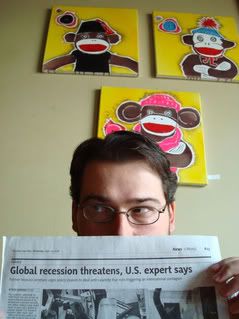















No comments:
Post a Comment